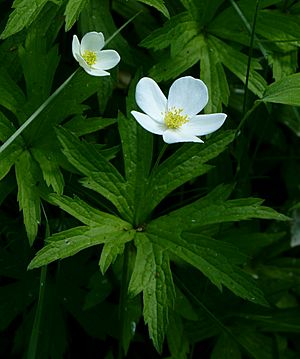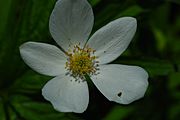Anemonastrum canadense facts for kids
Quick facts for kids Anemonastrum canadense |
|
|---|---|
 |
|
| Scientific classification | |
| Genus: |
Anemonastrum
|
| Species: |
canadense
|
| Synonyms | |
|
|
The Canada anemone, also known as Anemonastrum canadense or Anemone canadensis, is a beautiful wild plant. It's a type of perennial plant, which means it lives for more than two years. You can find it growing in wet places across North America.
This plant loves meadows, thickets, and the edges of streams and lakes. It spreads quickly using underground stems called rhizomes. People like it for its pretty white flowers. Other common names for it include round-headed anemone, meadow anemone, and windflower.
Contents
What Does the Canada Anemone Look Like?
The Canada anemone has stems that grow from underground parts called caudices. These stems are connected by long, thin rhizomes. The plant's stems can grow from about 8 to 31 inches (20 to 80 cm) tall.
Leaves
The leaves at the bottom of the plant are deeply cut and have jagged edges. They are usually about 1.5 to 4 inches (4 to 10 cm) long and 2 to 6 inches (5 to 15 cm) wide. These leaves grow on stalks that are about 3 to 8.5 inches (8 to 22 cm) long.
Flowers
The flowers of the Canada anemone are white and bloom from late spring into summer. Each flower has about five white, petal-like parts called sepals. These sepals are shaped like an upside-down egg, wider at the top. They are about 0.4 to 0.8 inches (10 to 20 mm) long.
In the center of the flower, you'll see 80 to 100 bright yellow stamens. These are the parts that make pollen. There are also green pistils, which are the female parts of the flower.
Seeds
After the flower is pollinated, the green pistils grow into a round or slightly long seed head. The seeds are called achenes. Each achene is almost round and has a small beak-like tip.
How the Canada Anemone Got Its Name
The Canada anemone was first described in 1768 by a famous scientist named Carl Linnaeus. He named it Anemone canadensis.
Over time, scientists learned more about how plants are related. They found that the group of plants called Anemone wasn't quite right. Some plants, like Clematis and Pulsatilla, seemed to be mixed in.
To make the plant groups more accurate, another scientist named Sergei Mosyakin moved the Canada anemone into a different group. He put it in the genus Anemonastrum, so its new scientific name became Anemonastrum canadense.
Where Does the Canada Anemone Grow?
Anemonastrum canadense is native to both Canada and the central and eastern parts of the United States. It's a common sight in these regions.
Uses of the Canada Anemone
Long ago, Indigenous peoples in North America used the Canada anemone for medicine. They used it to help with wounds, sores, and nosebleeds. They also used it as an eyewash. The root of the plant was especially valued by tribes on the Plains for many different health problems.
Is the Canada Anemone Safe?
Like many plants in its family (Ranunculaceae), the Canada anemone likely contains substances that can irritate skin or cause problems if eaten. It's always best to be careful and not touch or eat wild plants unless you know they are safe.
See also
 In Spanish: Anemone canadensis para niños
In Spanish: Anemone canadensis para niños


